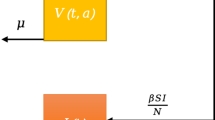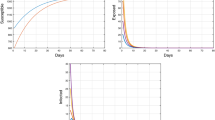Abstract
We consider an individual-based SIR stochastic epidemic model in continuous space. The evolution of the epidemic involves the rates of infection and recovering of individuals. We assume that individuals move randomly on the two-dimensional torus according to independent Brownian motions. We define the sequences of empirical measures, which describe the evolution of the positions of the susceptible, infected and removed individuals. We prove the convergence in probability, as the size of the population tends to infinity, of those sequences of measures towards the solution of a system of parabolic PDEs. We show that appropriately centrered renormalized sequences of fluctuations around the above limit converge in law, as the size of the population tends to infinity, towards a Gaussian distribution valued process, solution of a system of linear PDEs with highly singular Gaussian driving processes. In the case where the individuals do not move we also define and study the law of large numbers and central limit theorem for the same sequence.
Similar content being viewed by others
References
Adams, R.A.: Sobolev Spaces. Academic Press, Amsterdam (1975)
Allen, L.J.S., Bolker, B.M., Lou, Y., Nevai, A.L.: Asymptotic profiles of the steady states for an SIS epidemic reaction diffusion model. Discrete Contin. Dyn. Syst. Ser. A 21, 1–20 (2008)
Andersson, H., Britton, T.: Stochastic Epidemic Models and Their Statistical Analysis, Springer Lecture Notes in Statistics. Springer, New York (2000)
Bahouri, H., Chemin, J.-Y., Danchin, R.: Fourier Analysis and Nonlinear Partial Differential Equations. Springer, Berlin (2011)
Billingsley, P.: Convergence of Probability Measures, 2nd edn. Wiley, New York (1999)
Blount, D.: Density-dependant limits for a nonlinear reaction diffusion models. Ann. Probab. 22(4), 2040–2070 (1994)
Britton, T., Pardoux, E.: Stochastic epidemic in a homogeneous community. In: Britton, T., Pardoux, E. (eds.) Part I of Stochastic Epidemic Models with Inference. Lecture Notes in Mathematics, vol. 2225, pp. 1–120. Springer, Berlin (2019)
Clémençon, S., Tran, V.C., de Arazoza, H.: A stochastic SIR model with contact tracing: large population limits and statistical inference. J. Biol. Dyn. 2(4), 392–414 (2008)
Jacod, J., Shiryaev, A.N.: Limit Theorems for Stochastic Processes. Springer, Berlin (1987)
Joffe, A., Métivier, M.: Weak convergence of sequences of semimartingales with applications to multitype branching processes. Adv. Appl. Probab. 18(1), 20–65 (1986)
Kaj, I.: A weak interaction epidemic among diffusive particles. In: Etheridge, A. (ed.) Stochastic Partial Differential Equations. London Math. Soc. Lecture Note Series, vol. 216, pp. 189–208. Cambridge Univ. Press, Cambridge (1995)
Kipnis, C., Landim, C.: Scaling Limits of Interacting Particle Systems. Grundlehren der Mathematischen Wissenschaften [Fundamental Principles of Mathematical Sciences], vol. 320. Springer, Berlin (1999)
Kotelenez, P.: High density limit theorems for non linear chemical reactions with diffusion. Probab. Theory Relat. Fields 78, 11–37 (1998)
Kotelenez, P.: A stopped Doob inequality for stochastic convolution integrals and stochastic evolution equations. Stoch. Anal. Appl. 2(3), 245–265 (1984)
Lalley, S.P., Perkins, E.A., Zheng, X.: A phase transition for measure-valued SIR epidemic processes. Ann. Probab. 42, 237–310 (2014)
Métivier, M.: Convergence faible et principe d’invariance pour des martingales à valeurs dans des espaces de Sobolev. Annales de l’IHP 20(4), 329–348 (1984)
N’zi, M., Pardoux, É., Yeo, T.: A SIR model on a refining spatial grid I—Law of Large Numbers. Appl. Math. Optim. 83, 1153-1189
Pardoux, E.: Equations aux dérivées partielles stochastiques non linéaires monotones. Etudes des solutions fortes de type Itô, Thesis (1975)
Pardoux, E.: Stochastic partial differential equations and filtering of diffusion processes. Stochastics 3, 127–167 (1979)
Pardoux, E.: Probabilistic Models of Population Evolution. Scaling Limits, Genealogies and Interactions. Springer, Berlin (2016)
Pardoux, E.: Moderate deviations and extinction of an epidemic. Electron. J. Probab. 25(paper 25), 1–27 (2020)
Roelly-Coppoletta, S.: A criterion of convergence of measure-valued processes: application to measure branching processes. Stochastics 17, 43–65 (1985)
Roques, L., Bonnefon, O., Baudrot, V., Soubeyrand, S., Berestycki, H.: A parsimonious model for spatial transmission and heterogeneity in the COVID-19 propagation. R. Soc. Open Sci. 7, 201382 (2020)
Taylor, M.E.: Partial Differential Equations. III. Nonlinear Equations. Springer, Berlin (1991)
Funding
Alphonse Emakoua was supported by EMS Simons For Africa and an Eiffel scholarship program of excellence, and the two other authors by their respective university.
Author information
Authors and Affiliations
Corresponding author
Additional information
Publisher's Note
Springer Nature remains neutral with regard to jurisdictional claims in published maps and institutional affiliations.
Appendix
Appendix
We first recall that for any \(s>0\), the family \((\rho ^{i,s}_{n_{1},n_{2}})_{i,n_{1},n_{2}}\) (as defined in Proposition 2.3) is an orthonormal basis of \(H^{s}({\mathbb {T}}^{2})\).
In this appendix we prove the next two Lemmas.
Lemma 7.1
We have,
Proof
As for any \(x\in {\mathbb {T}}^{2}\), \(i \in [|1,8|]\), \(0\le (f_{n_{1},n_{2}}^{i}(x))^{2}\le 4\),
So
Hence we see that:
-
\(\displaystyle \sum \limits _{i,n_{1},n_{2}}(\rho _{n_{1},n_{2}}^{i,s}(x))^{2}<\infty \) provided the series \( \sum \limits _{n_{1}>0,n_{2}>0}\frac{1}{(1+\gamma \pi ^{2}(n_{1}^{2}+n_{2}^{2}))^{s}}\); \( \sum \limits _{n_{1}>0}\frac{1}{(1+\gamma \pi ^{2}n_{1}^{2})^{s}}\) and \( \sum \limits _{n_{2}>0}\frac{1}{(1+\gamma \pi ^{2}n_{2}^{2})^{s}}\) converge.
-
\( \displaystyle \sum \limits _{i,n_{1},n_{2}}(\nabla \rho _{n_{1},n_{2}}^{i,s}(x))^{2}<\infty \) provided the series \(\sum \limits _{n_{1}>0,n_{2}>0}\frac{n_{1}^{2}+n_{2}^{2}}{(1+\gamma \pi ^{2}(n_{1}^{2}+n_{2}^{2}))^{s}}\); \(\sum \limits _{n_{1}>0}\frac{n_{1}^{2}}{(1+\gamma \pi ^{2}n_{1}^{2})^{s}}\) and \(\sum \limits _{n_{2}>0}\frac{n_{2}^{2}}{(1+\gamma \pi ^{2}n_{2}^{2})^{s}}\) converge.
- Convergence of the series
-
(1)
Convergence of \(\sum \limits _{n_{1}>0,n_{2}>0}\frac{n_{1}^{2}+n_{2}^{2}}{(1+\gamma \pi ^{2}(n_{1}^{2}+n_{2}^{2}))^{s}}\)
It is so easy to see that \( \sum \limits _{n_{1}\ge 1,n_{2}\ge 1}\frac{n_{1}^{2}+n_{2}^{2}}{(1+\gamma \pi ^{2}(n_{1}^{2}+n_{2}^{2}))^{s}} \) and \(\displaystyle \int _{1}^{+\infty }\int _{1}^{+\infty }\frac{x^{2}+y^{2}}{(1+\gamma \pi ^{2}(x^{2}+y^{2}))^{s}}dxdy\) are of the same type (either convergent or divergent), and the latter is of the same type as
$$\begin{aligned} \displaystyle \int _{1}^{+\infty }\frac{r^{3}}{(1+\gamma \pi ^{2}r^{2})^{s}}dr \le \frac{1}{\gamma ^{s}\pi ^{2s}}\int _{1}^{+\infty }r^{3-2s}dr \end{aligned}$$and \(\int _{1}^{+\infty }r^{3-2s}dr<\infty \) iff \(\hbox {s}>2\).
Thus \(\sum \limits _{n_{1}\ge 1,n_{2}\ge 1}\frac{n_{1}^{2}+n_{2}^{2}}{(1+\gamma \pi ^{2}(n_{1}^{2}+n_{2}^{2}))^{s}} \) converges iff \(\hbox {s}>2\).
-
(2)
By the same argument as previously \( \sum \limits _{n_{1}>0,n_{2}>0}\frac{1}{(1+\gamma \pi ^{2}(n_{1}^{2}+n_{2}^{2}))^{s}} \) converges for s>1.
-
(3)
By the comparison criterion the series \(\sum \limits _{n_{1}>0}\frac{1}{(1+\gamma \pi ^{2}n_{1}^{2})^{s}}\) and \(\sum \limits _{n_{2}>0}\frac{1}{(1+\gamma \pi ^{2}n_{2}^{2})^{s}}\) converge for \(s>\frac{1}{2}\).
-
(4)
By the comparison criterion the series \(\sum \limits _{n_{1}>0}\frac{n_{1}^{2}}{(1+\gamma \pi ^{2}n_{1}^{2})^{s}}\) and \(\sum \limits _{n_{2}>0}\frac{n_{2}^{2}}{(1+\gamma \pi ^{2}n_{2}^{2})^{s}}\) converge for \(s>\frac{3}{2}\) \(\square \)
Lemma 7.2
Under the assumption (H2), for any \(t\ge 0\), we have
Proof
We have
Now if we let \(\displaystyle w_{t}(x,y)=\frac{K(x,y)}{\int _{{\mathbb {T}}^{2}}K(x',y)\mu _{t}(dx')}\), for any \(y\in {\mathbb {T}}^{2}\), one has
Furthermore from Lemma 5.1, \(\forall |\eta |\le 3\), \(x\in {\mathbb {T}}^{2}\), \(D^{\eta }K(x,y)\) is bounded by a constant independent of x. Thus since \(\forall y\in {\mathbb {T}}^{2}\), \(\int _{{\mathbb {T}}^{2}}K(u,y)\mu _{t}^{N}(du)=\int _{{\mathbb {T}}^{2}} K(u,y)f(t,u)(du)\) is lower bounded by a constant independent of y and \(f(t,.)\le \delta _{2}\) then we deduce from the above calculations that \(\displaystyle \sum \limits _{|\eta |\le 3}\int _{{\mathbb {T}}^{2}}\Big \vert D^{\eta } \frac{K(x,y)}{\int _{{\mathbb {T}}^{2}}K(x',y)\mu _{r}(dx')}\Big |^{2} dy\) is bounded by a constant independent of x. Hence the result.\(\square \)
Rights and permissions
About this article
Cite this article
Bowong, S., Emakoua, A. & Pardoux, E. A spatial stochastic epidemic model: law of large numbers and central limit theorem. Stoch PDE: Anal Comp 11, 31–105 (2023). https://doi.org/10.1007/s40072-021-00221-x
Received:
Revised:
Accepted:
Published:
Issue Date:
DOI: https://doi.org/10.1007/s40072-021-00221-x




